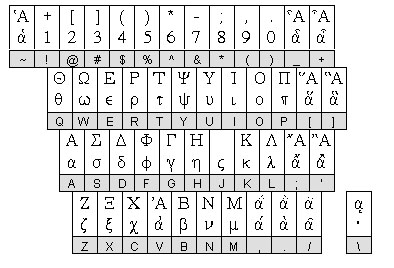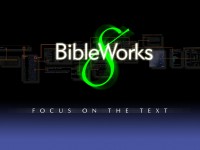In case you want or need them, here is a link for free Greek and Hebrew fonts.
http://www.bibleworks.com/fonts.html (Download and unpack the zip file on this page, then follow the instructions to install.)
Here are the keyboard layouts:


Liberating you from bad ideas about God
Stop relying on pastors and Bible teachers to tell you what the Bible means.
Read this book and learn to study the Bible for yourself. Available now on Amazon.
The book discussion questions with each chapter to make it perfect for a home study group. There is also a LONG appendix on how to understand the violent passages in Scripture.
In case you want or need them, here is a link for free Greek and Hebrew fonts.
http://www.bibleworks.com/fonts.html (Download and unpack the zip file on this page, then follow the instructions to install.)
Here are the keyboard layouts:


 I am so impressed with all the reference tools in BibleWorks 8. And not just the quantity, but the type of resources. There are Greek and Hebrew tools in BibleWorks you will not find anywhere else. Fantastic original language resources and background material.
I am so impressed with all the reference tools in BibleWorks 8. And not just the quantity, but the type of resources. There are Greek and Hebrew tools in BibleWorks you will not find anywhere else. Fantastic original language resources and background material.
Take, for example, the Salkinson-Ginsburg Hebrew New Testament. Yes, it is the New Testament, but in Hebrew. Many people believe that much of the original stories behind the New Testament text (and maybe parts of the text itself — such as the Gospel of Matthew) was originally in Hebrew, not Greek. So while you were hear lots of people talk about the importance of studying the Greek New Testament, there are huge advantages to studying the Hebrew New Testament as well. It was, after all, written primarily by Jews and for Jews. Studying the Salkinson-Ginsburg Hebrew New Testament was one of the things that helped me come to my conclusions on the recent paper I posted on Luke 6:1.
Anyway, I’m not aware of any other Bible Study software package that has this quantity and quality of original language resources. Below is the entire list of study resources in Bible Works 8. It is quite long, so I have included some hotlinks for you to jump to sections that interest you.
Shortcut to Sections:
Original Languages – Hebrew/Aramaic/Syriac
Original Languages – Greek
Bible Versions – English
Bible Versions – Other (they even have Swahili…)
Lexical-Grammatical Reference Works (Look at this list!…)
Other Reference Works (…this list too!)
* Modern Greek versions in separate section below
 When I was in India several years ago, many lepers walked the streets and begged. Some were missing ears and legs. Some missed fingers and toes. Unlike what we read in the Gospels, however, they did not stand off at a distance, crying out “Unclean! Unclean!” No, they came right up and touched us. And they kept touching until we either shooed them away or gave them some money.
When I was in India several years ago, many lepers walked the streets and begged. Some were missing ears and legs. Some missed fingers and toes. Unlike what we read in the Gospels, however, they did not stand off at a distance, crying out “Unclean! Unclean!” No, they came right up and touched us. And they kept touching until we either shooed them away or gave them some money.
At first, remembering what the Bible says about leprosy, we were scared to be touched by the lepers, but our trip leader told us not to worry about it. First of all, 95% of the world’s population is naturally immune to leprosy. And most of the 5% who can get it live in tropical, overpopulated, underdeveloped areas like Brazil, China, and India. Aside from this, even if you are susceptible to leprosy, nobody really knows how it is spread, but one common factor is prolonged close contact with someone who has it. You most likely won’t get it if you hug a leper or share a meal with one. But even if by some chance you do contract leprosy, we now have medical treatments available in developed countries like America that can pretty much cure it.
Yet even though we knew we could not get leprosy, it was one of the saddest things I have ever seen. One old lady with leprosy attended a church service I spoke at, and came up to me afterward. With the aid of a translator, she asked me to pray for her — not that she would be healed, but that she would die. That’s not a prayer request you get every day.
But that is how horrible leprosy is. And because it is so horrible, and so little is known about it, lepers are often cast out from society. They are rejected. They are treated like refuse. They are feared. They are despised. They are neglected and scorned.
It is true now, and was especially true in the time of Jesus because of the Jewish purity laws and lack of medicine to do anything about it. And yet, in Luke 5:12-16, we read that Jesus went up to a leper and touched him. This was more than a touch, but was close to a full-body embrace. Such an action showed the leper that he was no longer an outcast. He was accepted. He was loved. Can you imagine the shock that the disciples felt when Jesus did this? Can you imagine the amazement and awe that the leper felt?
Who is like this around you? Who is rejected? Who is despised? Who is overlooked?
What can you do to show them love and acceptance?
 I met again yesterday with a few friends to read and discuss Matthew. This time we were in chapter 3.
I met again yesterday with a few friends to read and discuss Matthew. This time we were in chapter 3.
And once again, I was amazed how easy it is for people to read and discuss Scripture, even when they may not know anything about it, or even believe it’s true. It’s not a magical book that requires arcane knowledge to decipher and understand. Just give people a decent translation (I recommend NKJV), and have them read and discuss it like any other book.
Matthew 3 talks about things like “repentance” and “baptism with the Holy Spirit and fire” and some other ideas that throw the Christian world into heated debates. I tried to stay out of the discussion as much as possible to see what they thought about such things.
These guys, consisting of atheists, agnostics, Buddhists, and Rastafarians, read the text, looked at the surrounding paragraphs to see what John was talking about, and came up with what (in my opinion) is a correct understanding of the passage. They didn’t really know what “repentance” meant, but they looked at the context and decided it was related to confession and meant turning away from sin. When they read about the baptism of the Holy Spirit and fire, they didn’t think about speaking in tongues or getting slain the Spirit. They didn’t think “fire” referred to hell.
All on their own, they realized that John was talking about people’s lives being renewed as they turned away from their old way of life and turned toward a new way of life following the Spirit of God. The “fire,” they thought, was a picture of this purification process.
I tell you, sometimes I wonder why I spent all that time and money going to Bible college and Seminary. If agnostics and atheists can know and understand the Bible and what it says better than many Christians I know, and even better than myself at times, who are the true “agnostics” and “atheists”? Who is it really that “doesn’t know”?
I listen to all kinds of music, from country to rap. I find that music reveals the soul of culture. And when it comes to music revealing the inner emotions and feelings of people, “secular” music does a better job than a lot of “Christian” music. It seems that the vast majority of Christian music is about being “happy, happy, happy all the time.”
Secular music understands that people have a whole range of emotions and feelings, and secular artists are not afraid to give voice to these feelings. So as I seek to understand culture, and interact with people around me, it helps to listen to he music they listen to and hear the pain, longing, and desires that drive them.
And while music runs the gamut of emotions, I hear two primary themes over and over again: People feel insecure and alone. Our world is awash in people who do not know what their future holds, and who have thousands of friends but feel alone most of the time. Of course, this message is not only found in music, but in art and movies as well.
Just as an example, I heard the following song on the radio last week. It is “Torn” by Natalie Imbruglia. The song is about her longing for love, and the fact that since she doesn’t think she’ll ever find it, she lives with perpetual insecurity. She doesn’t have faith any more that her relationships will last. Watch in the video that as she loses faith in love, her world is slowly torn down.
Do you know of any other songs that reveal these twin longings for security and relationships?
